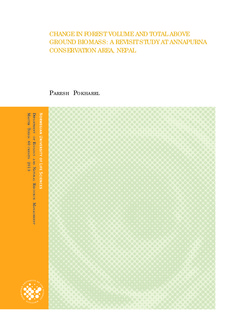| dc.description.abstract | Periodic assessment of forest resources is vital as forest plays regulatory role in maintaining
environmental balance and provides wide range of ecosystem services. In this context, a study
was carried in Mardi watershed inside Annapurna conservation area, Nepal. Current status of
stem volume (over bark) and total above ground biomass, and change in volume and biomass in
13 years (1999-2012) were assessed by measuring diameter of the trees (≥ 10 cm diameter at
breast height) and tree height at 40 sampling locations in three forest types, namely mixed
hardwood forest (MHF), oak forest (OF), and high mountain mixed forest (HMMF) using
stratified random sampling. Altitude, accessibility, aspect, and slope angle were also recorded in
each plot to assess the variability. Total of 48 tree species were encountered. A significant
variation in stem volume and total above ground biomass was found between and among forest
types. OF had highest stem volume and biomass (755.9 ± 53.2 m3
ha-1, 1166.2 ± 113 tons ha-1)
followed by HMMF (557.5±31.1 m3
ha-1, 766.4± 53.8 tons ha-1), and MHF (282.5 ± 32.2 m3
ha-1
,
302.5 ± 32.1 tons ha-1). Tree density was however higher in HMMF (1260 stems ha-1) than OF
(1130 stems ha-1), and MHF (805 stems ha-1). Difference in wood density, stem density, and size
of the trees between the forest types was the principal reason for such variation. The regression
analysis showed 89 % of variability in total aboveground biomass explained by altitude,
accessibility, and slope in OF and 80% of variability in HMMF. The estimated stem volume and
total above ground biomass were in general higher than figures reported in other parts of the
country and elsewhere. Comparison of present findings with the estimate of 1999 however, did
not show significant changes in stem volume and biomass densities among forest types.
Nevertheless, the present estimate revealed minor growth in stem volume, in MHF (from 232.6
to 282.5 m3
ha-1), OF (from 711 to 755.9 m3
ha-1), and HMMF (from 512.7 to 557.5 m3
ha-1)
since 1999. Similarly, total above ground biomass was also increased during this period in MHF
(from 270.8 to 302.5 tons ha-1), OF (from 1026.7 to 1166.2 tons ha-1), and HMMF (from 675.1 to
766.4 tons ha-1). Among the variable classes studied, a significant change in volume and biomass
in forests at higher altitude and low accessibility was observed during 13 years. The higher
volume and biomass in Mardi watershed and changes since 1999 may be mainly attributed to
cumulative effect of efficient conservation and management efforts by community involved and
favorable environment for productive forest. | no_NO |
